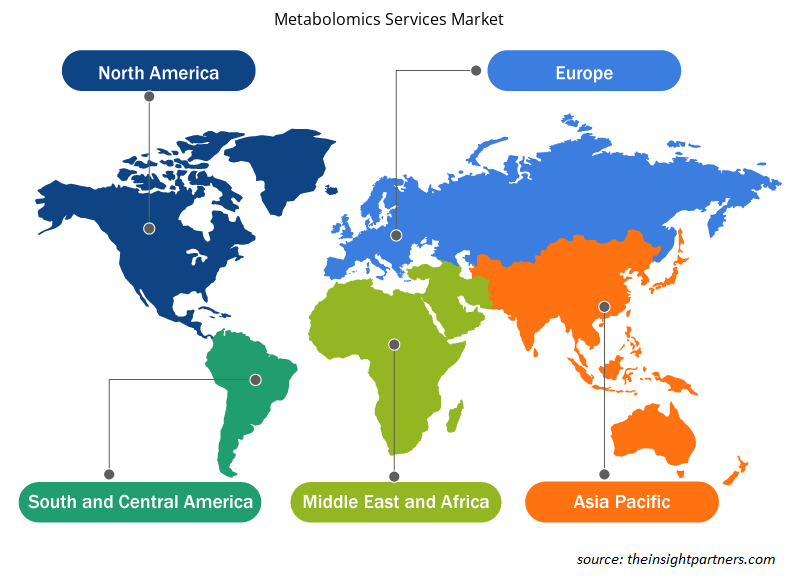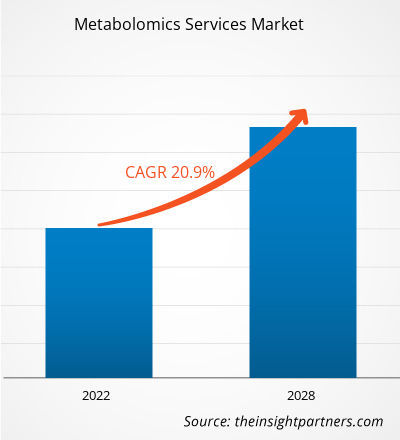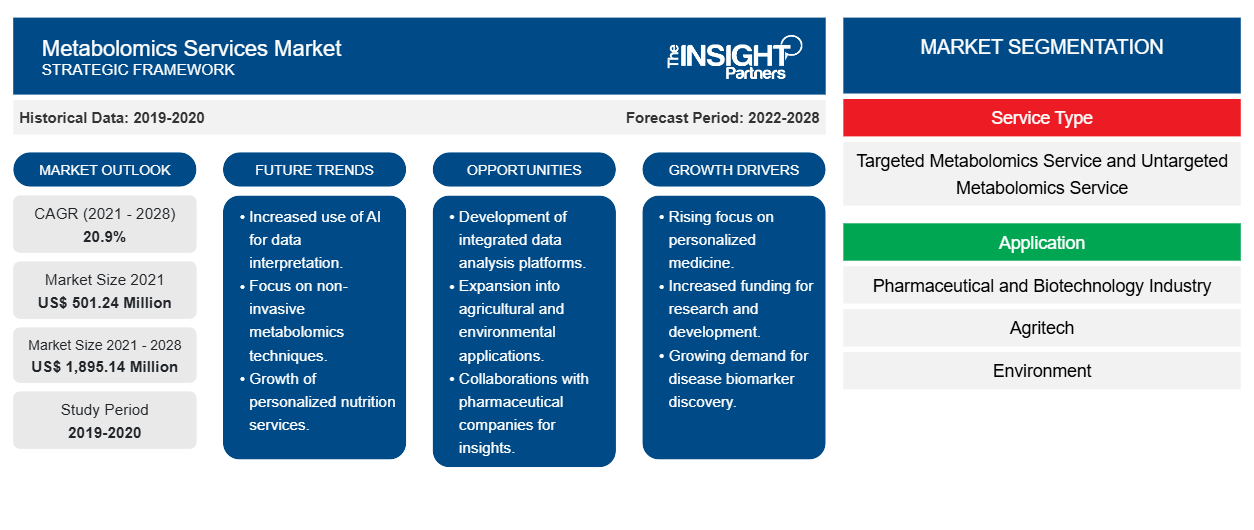[Forschungsbericht] Der Markt für Metabolomik-Dienstleistungen soll von 501,24 Millionen US-Dollar im Jahr 2021 auf 1.895,14 Millionen US-Dollar im Jahr 2028 anwachsen; von 2021 bis 2028 wird mit einer durchschnittlichen jährlichen Wachstumsrate von 20,9 % gerechnet.
Die Metabolomik ist die Untersuchung und Analyse biologischer Prozesse, an denen Stoffwechselzwischenprodukte und -nebenprodukte beteiligt sind – die Metabolome. Zu den Metabolomen zählen sekundäre Metabolite, Signalmoleküle, Hormone und Stoffwechselzwischenprodukte.
Der Bericht bietet eine eingehende Analyse des Marktes für Metabolomik-Dienstleistungen und legt dabei den Schwerpunkt auf Markttrends, technologische Fortschritte, Marktdynamik und Wettbewerbslandschaft (unter Beteiligung wichtiger Marktteilnehmer auf der ganzen Welt). Er umfasst auch die Auswirkungen der COVID-19-Pandemie auf den Markt in allen wichtigen Regionen. Nordamerika hält den größten Marktanteil, und das Marktwachstum in dieser Region ist auf die hohe Bekanntheit und Akzeptanz von Metabolomik-Dienstleistungen, die zunehmende Anzahl von Online-Einzelhändlern und die steigende Anzahl von Produktinnovationen und -einführungen zurückzuführen. Darüber hinaus dürften sich die wachsenden Ausgaben von Sextechnologieunternehmen im Prognosezeitraum auch positiv auf den nordamerikanischen Markt für Metabolomik-Dienstleistungen auswirken. Der Markt ist nach Regionen in Nordamerika, Europa, Asien-Pazifik (APAC), den Nahen Osten und Afrika (MEA) sowie Süd- und Mittelamerika (SAM) unterteilt.
Passen Sie diesen Bericht Ihren Anforderungen an
Sie erhalten kostenlose Anpassungen an jedem Bericht, einschließlich Teilen dieses Berichts oder einer Analyse auf Länderebene, eines Excel-Datenpakets sowie tolle Angebote und Rabatte für Start-ups und Universitäten.
- Holen Sie sich die wichtigsten Markttrends aus diesem Bericht.Dieses KOSTENLOSE Beispiel umfasst eine Datenanalyse von Markttrends bis hin zu Schätzungen und Prognosen.
Markteinblicke
Steigende Krebserkrankungen beflügeln Wachstum im Markt für Metabolomik-Dienstleistungen
Die Metabolomik gehört zu den wachsenden und robusten Technologien zur Erkennung einer breiten Palette von Metaboliten in Geweben und Bioflüssigkeiten. Dieses Verfahren findet eine bedeutende Anwendung in der Analyse und Erforschung von Krebserkrankungen. Die steigende Prävalenz verschiedener Krebsarten wird den Markt im Prognosezeitraum voraussichtlich antreiben. Die Krebsdiagnostik spielt eine wesentliche Rolle bei der Krebsbehandlung. Laut den im September 2021 von der Weltgesundheitsorganisation (WHO) veröffentlichten Daten wurden fast 70 % der Todesfälle durch Krebs in Ländern mit niedrigem und mittlerem Einkommen auf der ganzen Welt gemeldet. Der weltweite Anteil der Krebsinzidenz beträgt laut Aufzeichnungen des Global Cancer Observatory Brustkrebs (2,26 Millionen Fälle 11,7 %), Lungenkrebs (2,21 Millionen Fälle 11,4 %), Dickdarm und Mastdarm (1,93 Millionen Fälle 10 %), Prostatakrebs (1,41 Millionen Fälle 7,3 %) und Magenkrebs (1,09 Millionen Fälle 5,6 %). Nachfolgend finden Sie die Einzelheiten zur regionalen Prävalenz im Jahr 2020:
- Dieses KOSTENLOSE Beispiel umfasst eine Datenanalyse von Markttrends bis hin zu Schätzungen und Prognosen.
Servicetypbasierte Einblicke
Der Markt für Metabolomik-Dienste wurde je nach Diensttyp in zielgerichtete Metabolomik-Dienste und nicht zielgerichtete Metabolomik-Dienste segmentiert. Das Segment der zielgerichteten Metabolomik-Dienste dürfte 2021 einen größeren Marktanteil halten. Darüber hinaus wird erwartet, dass das Segment der zielgerichteten Metabolomik-Dienste im Prognosezeitraum eine höhere durchschnittliche jährliche Wachstumsrate (CAGR) auf dem Markt verzeichnet.
Anwendungsbasierte Erkenntnisse
Der Markt für Metabolomik-Dienstleistungen ist je nach Anwendung in die Bereiche Pharma- und Biotechnologie, Agrartechnologie und Umwelt unterteilt. Das Segment Pharma- und Biotechnologie wird voraussichtlich im Jahr 2021 den größten Marktanteil halten. Darüber hinaus wird erwartet, dass der Markt für dieses Segment im Zeitraum von 2021 bis 2028 mit einer durchschnittlichen jährlichen Wachstumsrate von 21,6 % am schnellsten wächst.
Die Akteure auf dem Markt für Metabolomik-Dienstleistungen verfolgen organische Strategien wie Produkteinführung und -expansion, um ihre globale Präsenz und ihr Produktportfolio zu erweitern.
Regionale Einblicke in den Markt für Metabolomik-Dienste
Die regionalen Trends und Faktoren, die den Markt für Metabolomics-Dienste im Prognosezeitraum beeinflussen, wurden von den Analysten von Insight Partners ausführlich erläutert. In diesem Abschnitt werden auch die Marktsegmente und die Geografie von Metabolomics-Diensten in Nordamerika, Europa, im asiatisch-pazifischen Raum, im Nahen Osten und Afrika sowie in Süd- und Mittelamerika erörtert.

- Erhalten Sie regionale Daten zum Markt für Metabolomics-Dienstleistungen
Umfang des Marktberichts zu Metabolomik-Dienstleistungen
| Berichtsattribut | Details |
|---|---|
| Marktgröße im Jahr 2021 | 501,24 Millionen US-Dollar |
| Marktgröße bis 2028 | 1.895,14 Millionen US-Dollar |
| Globale CAGR (2021 - 2028) | 20,9 % |
| Historische Daten | 2019-2020 |
| Prognosezeitraum | 2022–2028 |
| Abgedeckte Segmente | Nach Servicetyp
|
| Abgedeckte Regionen und Länder | Nordamerika
|
| Marktführer und wichtige Unternehmensprofile |
|
Marktteilnehmerdichte: Der Einfluss auf die Geschäftsdynamik
Der Markt für Metabolomics-Dienstleistungen wächst rasant. Dies wird durch die steigende Nachfrage der Endnutzer aufgrund von Faktoren wie sich entwickelnden Verbraucherpräferenzen, technologischen Fortschritten und einem größeren Bewusstsein für die Vorteile des Produkts vorangetrieben. Mit der steigenden Nachfrage erweitern Unternehmen ihr Angebot, entwickeln Innovationen, um die Bedürfnisse der Verbraucher zu erfüllen, und nutzen neue Trends, was das Marktwachstum weiter ankurbelt.
Die Marktteilnehmerdichte bezieht sich auf die Verteilung der Firmen oder Unternehmen, die in einem bestimmten Markt oder einer bestimmten Branche tätig sind. Sie gibt an, wie viele Wettbewerber (Marktteilnehmer) in einem bestimmten Marktraum im Verhältnis zu seiner Größe oder seinem gesamten Marktwert präsent sind.
Die wichtigsten auf dem Markt für Metabolomik-Dienstleistungen tätigen Unternehmen sind:
- BASF SE
- TMIC
- Kreative Proteomik
- BGI
- RTI International
Haftungsausschluss : Die oben aufgeführten Unternehmen sind nicht in einer bestimmten Reihenfolge aufgeführt.

- Überblick über die wichtigsten Akteure auf dem Markt für Metabolomik-Dienstleistungen
Nach Servicetyp
- Gezielter Metabolomik-Dienst
- Dienst für nicht zielgerichtete Metabolomik
Nach Anwendung
- Pharmazeutische und biotechnologische Industrie
- Biomarker-Erkennung
- Arzneimittelforschung
- Toxikologische Tests
- Sonstiges
- Agrartechnik
- Umfeld
Von
Geographie
Nordamerika
- UNS
- Kanada
- Mexiko
Europa
- Frankreich
- Deutschland
- Italien
- Vereinigtes Königreich
- Spanien
- Restliches Europa
Asien-Pazifik (APAC)
- China
- Indien
- Südkorea
- Japan
- Australien
- Restlicher Asien-Pazifik-Raum
Naher Osten und Afrika (MEA)
- Südafrika
- Saudi-Arabien
- Vereinigte Arabische Emirate
- Rest von MEA
Süd- und Mittelamerika (SCAM)
- Brasilien
- Argentinien
- Rest von SCAM
Firmenprofile
- BASF SE
- TMIC
- Kreative Proteomik
- BGI
- RTI International
- Afekta Technologies Ltd.
- Fred Hutchinson Krebsforschungszentrum
- Westküste Metabolomics Center
- Molekulares Ich
- Metabolon, Inc.
- biocrates life sciences ag
- Chenomx Inc.
- C-CAMP
- metaSysX
- MS-Omics
- Historische Analyse (2 Jahre), Basisjahr, Prognose (7 Jahre) mit CAGR
- PEST- und SWOT-Analyse
- Marktgröße Wert/Volumen – Global, Regional, Land
- Branchen- und Wettbewerbslandschaft
- Excel-Datensatz
Aktuelle Berichte
Erfahrungsberichte
Grund zum Kauf
- Fundierte Entscheidungsfindung
- Marktdynamik verstehen
- Wettbewerbsanalyse
- Kundeneinblicke
- Marktprognosen
- Risikominimierung
- Strategische Planung
- Investitionsbegründung
- Identifizierung neuer Märkte
- Verbesserung von Marketingstrategien
- Steigerung der Betriebseffizienz
- Anpassung an regulatorische Trends





















 Kostenlose Probe anfordern für - Markt für Metabolomik-Dienstleistungen
Kostenlose Probe anfordern für - Markt für Metabolomik-Dienstleistungen